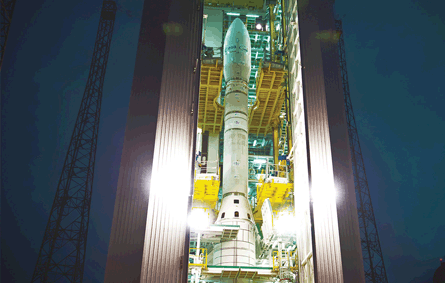Europe's next push into space gets off to a slightly anxious start this year with a tight window for the maiden launch of the all-new light rocket, Vega.
Twelve months ago, when European Space Agency director general Jean-Jacques Dordain proclaimed 2011 to be ESA's "year of launchers", he had hoped to close the year with three launcher options. But while ESA and its launch operator, Arianespace, successfully inaugurated medium-lift Soyuz operations from their space centre at Kourou in French Guiana, readiness considerations pushed Vega into 2012, with a 29 January launch date set last October, when the final go-ahead was approved.
Year-end was never a critical deadline for Vega, but its launch did have to be fit in between the maiden Soyuz flight - on 20 October - and the start of final preparations for the next flight of ESA's venerable Ariane 5 heavy-lift workhorse on 9 March. So, when Vega's launch slipped to "late January or early February", the timetable got tight.
 |
|---|
© ESA The European Space Agency is set for the maiden launch of its Vega light rocket this year |
Just how tight was made clear this week when Dordain, speaking in Paris to outline ESA's programme for 2012, revealed that 9 February would be the day. He is getting a daily progress report from the countdown campaign and believes that deadline can be met - with, he stressed more than once, "no compromise" when it comes to resolving every issue that could jeopardise a successful launch.
However, he said, there will only be a couple of days grace period to get Vega off the pad or scrub the launch and move it to a later date, because it cannot be allowed to interfere with preparations for the Ariane 5 mission, to launch ESA's third Automated Transfer Vehicle (ATV) robotic supply ship to the International Space Station. Traffic to the ISS is heavy enough that there is simply no scope for rescheduling ATV-3.
The first Vega mission will orbit the Lares and AlmaSat-1 satellites, along with several microsatellites.
Launch operator Arianespace says it could stretch to "five or six" days after 9 February. The problem is that both missions will put payloads in a similar orbit - 51° for ATV-3. Arianespace thus relies for both flights on the same "down range" ground stations, including boats in the Atlantic, which need to be moved and reconfigured for each mission.
Dordain noted that a subsequent flight to a geostationary transfer orbit would pose no problem - and added that it is just as well that 2012 is a leap year.
CHALLENGE 2012
Such scheduling problems will increasingly characterise ESA's planning, as one of the great challenges the agency faces in 2012 is the rising number of launches from French Guiana - about one a month this year, via three different launch vehicles with payloads ranging from commercial telecommunications satellites and several of Europe's Galileo navigation satellites to ISS supplies and Earth-observation equipment.
As Dordain puts it, for the first time ever ESA has a launch manifest to help plan missions so as to avoid interference: "We can no longer choose the dates for a mission in splendid isolation."
Other highlights for 2012 include the return in May from the ISS of ESA astronaut André Kuipers, who will have been the prime operator of ATV-3 on its rendezvous and docking with the station in March. The launch in July - from Baikonur in Kazakhstan - of the multi-satellite "Swarm" mission promises to provide the best-ever survey of Earth's magnetic field, improving knowledge of the Earth's interior and climate.
ESA is itself expanding. Romania formally became the agency's 19th member state in December, and negotiations are under way with Poland, hopefully to be concluded by March. Malta signed a cooperation agreement in December, and if cooperation negotiations under way with Bulgaria conclude successfully, all EU members will have some agreement with ESA.
But Dordain is keenly aware that ESA's greatest challenge for 2012 is the very terrestrial matter of money. At €4.02 billion, ESA's 2012 budget is on a par with the past couple of years. And, he adds, while funding has yet to finalised, agreement in principle has been reached on key plans such as ESA's ISS operations through 2020 and the development of a heavier version of the Ariane 5 rocket. Such programmes represent about €1 billion so far, a "not trivial" amount which "illustrates that member states take space very, very seriously", said Dordain.
However, while declining to give names, Dordain admits that some member states - not any of the biggest budget contributors - have struggled to make their contributions, and he has had to work with the others to make up shortfalls.
In this environment, ESA must ask "for exactly the right amount of money", said Dordain, adding: "I don't want to feed the deficits of the member states."
Meanwhile, ESA has recently found "several tens of millions of euros" of cost savings and Dordain's short-term goal is to find another €175 million ($224 million).
ESA is undoubtedly fortunate to have a leader who combines a scientist's clear view of what is technically possible with a consummate politician's gift for convincing ESA's member states that they are getting good value for money. But Dordain is under no illusions about the challenges he faces in keeping up ESA's momentum in economically difficult times: "We live on the same planet as everybody else."
Source: Flight International





























